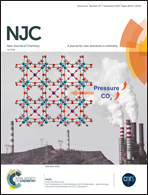Synthesis, characterisation, crystal structures and biological studies of palladium(ii) complexes containing 5-(2-hydroxy-3-methoxy-phenyl)-2,4-dihydro[1,2,4]triazole-3-thione derivatives†
Abstract
A series of new Pd(II) complexes (1–4) were obtained from the reactions between K2[PdCl4], 3-methoxysalicylaldehyde-4(N)-substituted thiosemicarbazone [H2L1–H2L4] and 1,3-bis(diphenylphosphino)propane [dppp]. All the complexes were characterized by various spectroscopic techniques (IR, electronic, 1H-NMR and ESI-MS). The crystal structures of complexes 2 and 4 have been determined by single crystal X-ray diffraction. The binding affinity and binding mode of the palladium complexes (1–4) towards calf-thymus (CT) DNA and BSA (Bovine Serum Albumin) were studied by using UV-vis and fluorescence emission spectroscopy. These results showed that the binding of the complexes to DNA is through electrostatic interaction and the quenching of the complexes is static. Further they cleaved supercoiled DNA pBR322 without any added external agents. The alterations in the secondary structure of BSA by the Pd(II) complexes were confirmed by synchronous and three dimensional fluorescence spectroscopy. The cytotoxicity of the complexes was evaluated by an MTT assay in the MCF-7 cell line and complex 3 exhibited significant activity (IC50 = 5.60 ± 0.04 μM), which was comparable with those of the other complexes. The morphological changes assessed by acridine orange and ethidium bromide staining revealed that the cell death occurred through apoptosis.
![Graphical abstract: Synthesis, characterisation, crystal structures and biological studies of palladium(ii) complexes containing 5-(2-hydroxy-3-methoxy-phenyl)-2,4-dihydro[1,2,4]triazole-3-thione derivatives](/en/Image/Get?imageInfo.ImageType=GA&imageInfo.ImageIdentifier.ManuscriptID=C8NJ03714K&imageInfo.ImageIdentifier.Year=2018)


 Please wait while we load your content...
Please wait while we load your content...